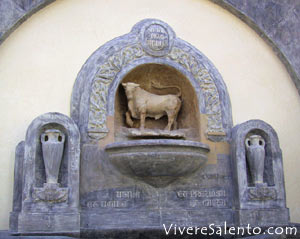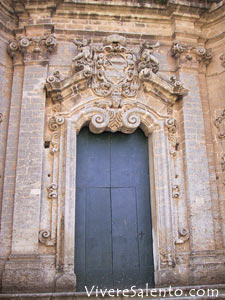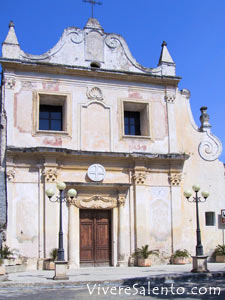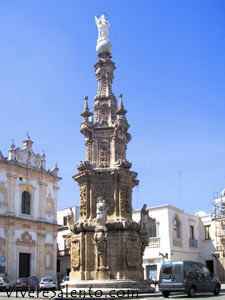|
|

The monuments of Nardò are certainly worth visiting. The
castle was rebuilt in 1490 on a pre-existing building dating to the 1270. It has
a square plan and four round towers. In 1900 the Personnès remade the front in a
 Neoclassical
style and in 1934 the castle became the Town Hall. There are also several
beautiful palaces such as the Bishop Palace (next to the cathedral) was built in
1830 according to the will of the Bishops Lettieri, Riccardi and Vetta. The coat
of arms of the latter can be seen on one of the arcs leading to the garden. In
the palace the tourist can visit several paintings of sacral subjects but also
the portraits of all the bishops from 1413 on. Chiodo Palace was built in the
16th century by Vittorio Chiodo, faithful subject of Carlo V who made him Knight
and allowed him to give immunity and asylum in his palace. The whole building
was restructured and there are valuable 16th century frescos. Tafuri Palace was
built in the 17th century and was restored several times, its front dates to
1841. Inside there is the Chapel of the Virgin. Other palaces are Colosso
Palace, Aprile Palace (16th century), Fedele Palace, Tarantino Palace, Gaballo
Palace, Potenza palace (17th century), Maritati Palace, Zuccalà Palace (14th
century), Fonte Palace (19th century) and many Neoclassical
style and in 1934 the castle became the Town Hall. There are also several
beautiful palaces such as the Bishop Palace (next to the cathedral) was built in
1830 according to the will of the Bishops Lettieri, Riccardi and Vetta. The coat
of arms of the latter can be seen on one of the arcs leading to the garden. In
the palace the tourist can visit several paintings of sacral subjects but also
the portraits of all the bishops from 1413 on. Chiodo Palace was built in the
16th century by Vittorio Chiodo, faithful subject of Carlo V who made him Knight
and allowed him to give immunity and asylum in his palace. The whole building
was restructured and there are valuable 16th century frescos. Tafuri Palace was
built in the 17th century and was restored several times, its front dates to
1841. Inside there is the Chapel of the Virgin. Other palaces are Colosso
Palace, Aprile Palace (16th century), Fedele Palace, Tarantino Palace, Gaballo
Palace, Potenza palace (17th century), Maritati Palace, Zuccalà Palace (14th
century), Fonte Palace (19th century) and many others. Another interesting monument is the Hosanna Obelisk (17th century). It
has an octagonal plan and in past times, there used to be religious celebrations
in the nearby. Opposite to it there was one of the former doors of the town, St
Paul’s Door. In Nardò, there is one of the most beautiful squares of the nation,
that is Salandra Square, formerly Logs’ Square. Here is the stately Spire of the
Virgin which dates to 1769. It is made in our local stone, is 19m tall and, at
the top of it, there is a statue of the Virgin. In the same square there is the
Fountain of the Bull which recalls the civic coat of arms. The fountain was
created by Michele Gaballo and Raffale Borgia and built in 1930. The most
important church is certainly the Cathedral. The original structure dates back
to 11th century by Goffredo the Norman and was dedicated to St Mary de Nerito.
Nowadays the cathedral is dedicated to Our Lady of the Assumption. It has a nave
and two aisles, a wooden ceiling and its columns have beautiful capitals. The
baroque altars are very interesting as well as the paintings, such as that
representing the Virgin by Francesco Solimena, and the frescos. The relics of
same saints are preserved in a wooden cupboard that can be visited once a year
on All Saints Day. In 1879 the building became National Monument and became
Basilica in 1980. The Church of St Sophia dates to the 16th century. The fresco
of this Saint and that
others. Another interesting monument is the Hosanna Obelisk (17th century). It
has an octagonal plan and in past times, there used to be religious celebrations
in the nearby. Opposite to it there was one of the former doors of the town, St
Paul’s Door. In Nardò, there is one of the most beautiful squares of the nation,
that is Salandra Square, formerly Logs’ Square. Here is the stately Spire of the
Virgin which dates to 1769. It is made in our local stone, is 19m tall and, at
the top of it, there is a statue of the Virgin. In the same square there is the
Fountain of the Bull which recalls the civic coat of arms. The fountain was
created by Michele Gaballo and Raffale Borgia and built in 1930. The most
important church is certainly the Cathedral. The original structure dates back
to 11th century by Goffredo the Norman and was dedicated to St Mary de Nerito.
Nowadays the cathedral is dedicated to Our Lady of the Assumption. It has a nave
and two aisles, a wooden ceiling and its columns have beautiful capitals. The
baroque altars are very interesting as well as the paintings, such as that
representing the Virgin by Francesco Solimena, and the frescos. The relics of
same saints are preserved in a wooden cupboard that can be visited once a year
on All Saints Day. In 1879 the building became National Monument and became
Basilica in 1980. The Church of St Sophia dates to the 16th century. The fresco
of this Saint and that
 of
Jesus Crucified are very interesting. The Church of St Anthony from Padua was
built in the 15th century on the rests of an old synagogue. It was restructured
several times. The façade (by the Manieri) looks very sober instead the inside
is richly decorated in baroque style. Inside there is a 17th century organ, some
frescos and several paintings such as that representing Jesus. Next to the
cathedral there is a convent of the 17th century. Its frescos need restoration
and represent the Miracle of St Francis from Assisi and the fight between
Saracens and Christians. The Church of the Virgin of the Purity was planned by
the Bishop Ferdinando Sanfelice and was built in the 18th century. On its portal
there is the Bishop coat of arms and inside a plaque remembers Sanfelice as a
token of thankfulness. The small Church of St Lawrence dates back to the 16th
century and was restored several times. Inside there is a fresco of the
Crucified. The Church of the Carmine dates to the 1400 but was restored and
rebuilt several times between 1528 and 1754. Its portal is stately and richly
decorated. The inside is in baroque style and there is a 17th century wooden
organ and a particular painting representing St Elia by Donato Antonio
d’Orlando. Next to this church there was a Carmelite Monastery built by several
important artist such as Tommaso Riccio and Giovanni Maria Tarantino. Nowadays
it belongs to the municipality. The Church of St Trifone was built in the 18th
century and is characterised by a sober façade as simple as the inside. The
Church of the Nunziatella dates back probably to the 15th century but in 1500
was knocked down according of
Jesus Crucified are very interesting. The Church of St Anthony from Padua was
built in the 15th century on the rests of an old synagogue. It was restructured
several times. The façade (by the Manieri) looks very sober instead the inside
is richly decorated in baroque style. Inside there is a 17th century organ, some
frescos and several paintings such as that representing Jesus. Next to the
cathedral there is a convent of the 17th century. Its frescos need restoration
and represent the Miracle of St Francis from Assisi and the fight between
Saracens and Christians. The Church of the Virgin of the Purity was planned by
the Bishop Ferdinando Sanfelice and was built in the 18th century. On its portal
there is the Bishop coat of arms and inside a plaque remembers Sanfelice as a
token of thankfulness. The small Church of St Lawrence dates back to the 16th
century and was restored several times. Inside there is a fresco of the
Crucified. The Church of the Carmine dates to the 1400 but was restored and
rebuilt several times between 1528 and 1754. Its portal is stately and richly
decorated. The inside is in baroque style and there is a 17th century wooden
organ and a particular painting representing St Elia by Donato Antonio
d’Orlando. Next to this church there was a Carmelite Monastery built by several
important artist such as Tommaso Riccio and Giovanni Maria Tarantino. Nowadays
it belongs to the municipality. The Church of St Trifone was built in the 18th
century and is characterised by a sober façade as simple as the inside. The
Church of the Nunziatella dates back probably to the 15th century but in 1500
was knocked down according to the will of the Bishop Bovio, because it was unstable. It was rebuilt in 1611
but since it had been desecrated, it is now used as a meeting place. The Church
of St Lucy was rebuilt in 1725 on a pre-existing structure of the 15th century.
The Church of St Chiara was thoroughly rebuilt in 1600 while the Convent dates
to the 16th century and was run by the Nuns of St Chiara. The façade of the
church is very sober while the inside is decorated in baroque style. The convent
was restored several times and there is an interesting antependium of the 18th
century which is used as a decoration on the high altar on St Chiara’s day. The
Church of the Souls is next to the Cathedral and dates probably to the 16th
century. There are beautiful paintings such as that of Our Lady of the Milk by a
Neapolitan painter. The Confraternity of the Souls has managed it since 1600.
The old Church of St Lawrence was built in 1400 and was restored in 1800. It is
now closed to public and belongs to the Fontes. The Church of St Bartholomew was
built according to the will of the Bishop De Franchis in the 17th century and
there is a appreciated painting of the saint. The Church of St Mary of the
Coronation was probably planned by the Tarantino and was built together with th
Convent at the end of 1500. The Church of st Gerardo was built in 1971 by
Antonio Prete and looks very simple. The Church of St Joseph the Patriarch was
restored between 1758 and 1788. It has an octagonal plan as we can see from the
Façade. Inside there are some beautiful paintings of the 18th century such as
that representing St Joseph with the Child. There are even other churches such
as the Church of Saint Teresa of Avila (17th century), the Church of St. Francis
of Paola (17th century), the Church of the Medical Saints (15th century), the
Church of the Charity (16th century), the Church of the Blessed Virgin Maria
(16th century), the Church of St. Dominic (17th century), the Church of the
Saint Cross (16th century) and the Church of St. Giovanni the Baptist (18th
century). The patron saint of Nardò is St Gregorio and he is celebrated on 20th
February.
to the will of the Bishop Bovio, because it was unstable. It was rebuilt in 1611
but since it had been desecrated, it is now used as a meeting place. The Church
of St Lucy was rebuilt in 1725 on a pre-existing structure of the 15th century.
The Church of St Chiara was thoroughly rebuilt in 1600 while the Convent dates
to the 16th century and was run by the Nuns of St Chiara. The façade of the
church is very sober while the inside is decorated in baroque style. The convent
was restored several times and there is an interesting antependium of the 18th
century which is used as a decoration on the high altar on St Chiara’s day. The
Church of the Souls is next to the Cathedral and dates probably to the 16th
century. There are beautiful paintings such as that of Our Lady of the Milk by a
Neapolitan painter. The Confraternity of the Souls has managed it since 1600.
The old Church of St Lawrence was built in 1400 and was restored in 1800. It is
now closed to public and belongs to the Fontes. The Church of St Bartholomew was
built according to the will of the Bishop De Franchis in the 17th century and
there is a appreciated painting of the saint. The Church of St Mary of the
Coronation was probably planned by the Tarantino and was built together with th
Convent at the end of 1500. The Church of st Gerardo was built in 1971 by
Antonio Prete and looks very simple. The Church of St Joseph the Patriarch was
restored between 1758 and 1788. It has an octagonal plan as we can see from the
Façade. Inside there are some beautiful paintings of the 18th century such as
that representing St Joseph with the Child. There are even other churches such
as the Church of Saint Teresa of Avila (17th century), the Church of St. Francis
of Paola (17th century), the Church of the Medical Saints (15th century), the
Church of the Charity (16th century), the Church of the Blessed Virgin Maria
(16th century), the Church of St. Dominic (17th century), the Church of the
Saint Cross (16th century) and the Church of St. Giovanni the Baptist (18th
century). The patron saint of Nardò is St Gregorio and he is celebrated on 20th
February.

The other villages take fun of the inhabitants of Nardò
because of their behaviour during a Saracen attack in 1255. The people of Nardò
are very proud of their history ( the village was probably founded by the
Egyptians in 3000 B.C.) but they were not able to resist the Saracens’ attacks
and can not tolerate to be taken fun of, so they created a legend which probably
tells the opposite of what actually happened. The legend says that the Saracens
came near Nardò and stopped to rest before the final attack. One of them fell
asleep near a bush of nettles and eventually finished on it. He woke up suddenly
screaming and scratching himself. The legend says that the Saracens were
impressed by the hostility of that grass and thought that the men living there
would be even tougher so they decided to leave the siege and go away.
Special
Thank to Gruppo Speleologico Neretino (Nardò) for their kind collaboration.
|